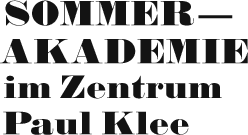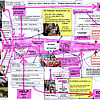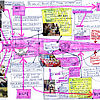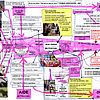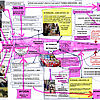Theme
by Thomas Hirschhorn
Multilingual maps by Thomas Hirschhorn, Courtesy the Artist, 2007
Where do I stand? What do I want?
"It’s about having a plan. The plan ‘Where do I stand? What do I want?’ is my plan. It highlights my position. It is neither an historical nor a scientific document, and this plan is not about facts and certainties. The plan ‘Where do I stand? What do I want?’ is first and foremost a form, the plan gives form. I want to give form. Form interests me, to give form, this is my work. In my work, in my art, with every single work and with every exhibition I want to show that I take a position and that I have a plan. It’s about making a statement as an artist, as to where I really stand, what I really want. It is about asserting yourself as an artist, to take a stand. It is of importance to me to clarify my position, to maintain and defend it. For that, I need help, I need tools, I need to know which are my influences, I need encouragement, I need to be aware of the dangers, I need to know my problems, and I need love. Love for art and love for philosophy.
The plan is the first step for the frame, for the construction, the sculpture. It is two-dimensional. I have to convert it to three dimensions. All my works are plans or collages which have been transformed into the third dimension, I make collages in space. I never start from volume, but always build up a plan which is sketched in my head. The plan, the form always starts in my mind. I’m interested in a plan which can’t be worked out in a linear way, and by the fact that I need to interpret it. This interpretation has to be real, true, my own interpretation. It has to originate from my own.
Art is about having an intention, a mission, a problem. And it’s about giving form to this problem or mission under necessity, with headlessness and urgency. The plan is one of such forms, a claim, a challenge to myself: I have a plan, an idea, a project, a position. I must and I will assert my position and defend my plan. It’s about asking an artist the fundamental, the big question, the only important question, and to try to answer it through my work. That question is: ‘Where do I stand? What do I want?’.
For me, it can only be about this: Do I have the power, the determination, the passion and the competence to make a work of art – to assert a form that has bite and demands as much of the beholder as it does of me: everything. That’s what’s on the plan ‘Where do I stand? What do I want?’. Everything on it counts, everything on it is important and everything on it is right!
Contained within the question ‘Where do I stand? What do I want?’ is the question to the other: ‘What do you want? Where do you stand?’. That is the political point in this question to myself: I ask myself, first, but also address the other. I want to know: What is your form? What does your plan look like? It’s about laying the groundwork, setting conditions as an artist, to give something first so I can ask the other what s/he’s giving, in order to demand and claim it! That is the logic behind the plan ‘Where do I stand? What do I want?’.
I know what it takes to develop an artistic logic: Love, passion, hope, courage, taking risk, commitment to form, resilience, assertiveness, headlessness, and unconditional insistence on the autonomy of art. And the readiness – as an artist – to be the first to pay for one’s work, for art. I also know that an artist has to be a warrior."
Thomas Hirschhorn
ALL EVENTS DURING THE ACADEMY WILL BE OPEN TO THE PUBLIC!
